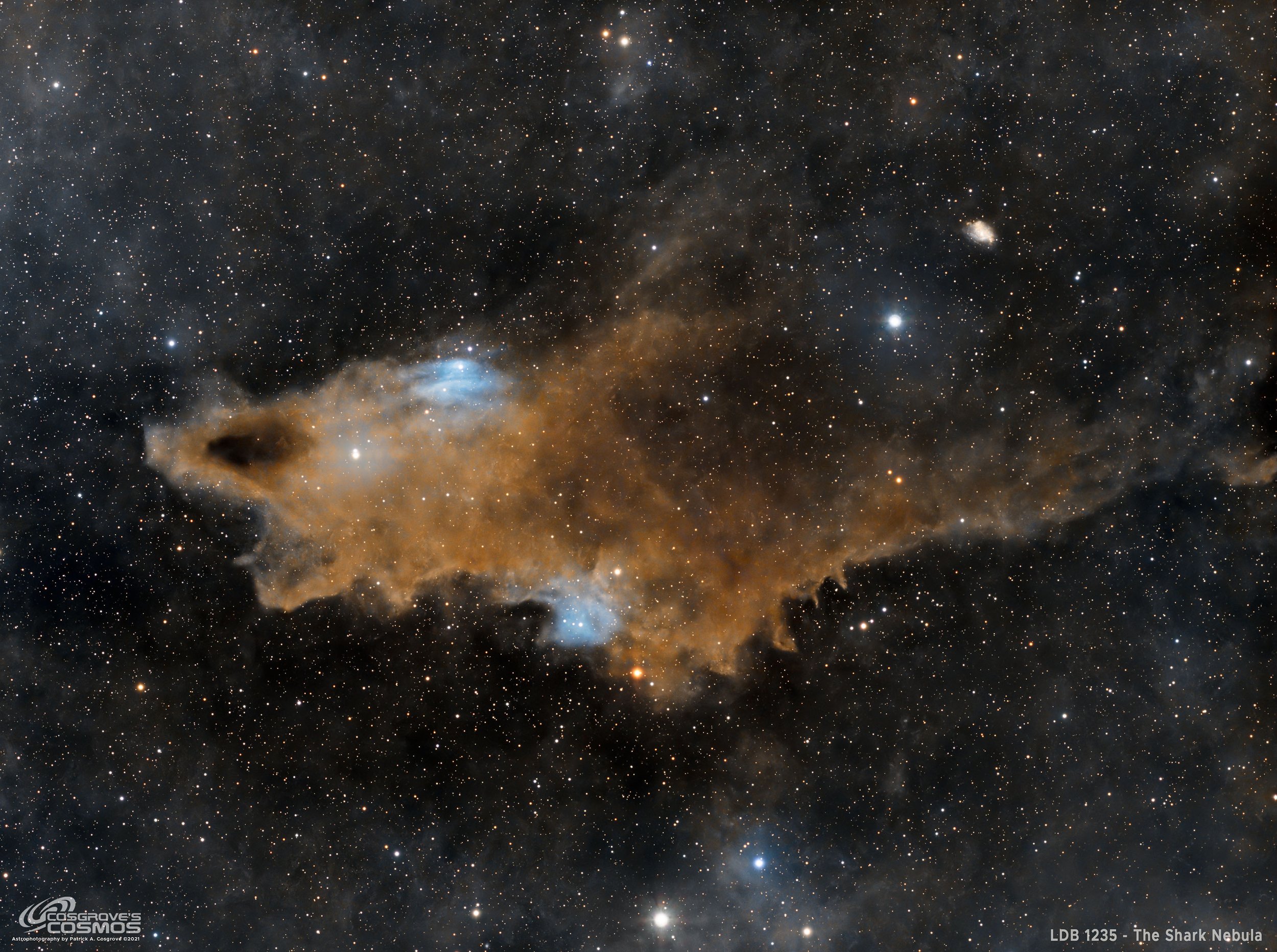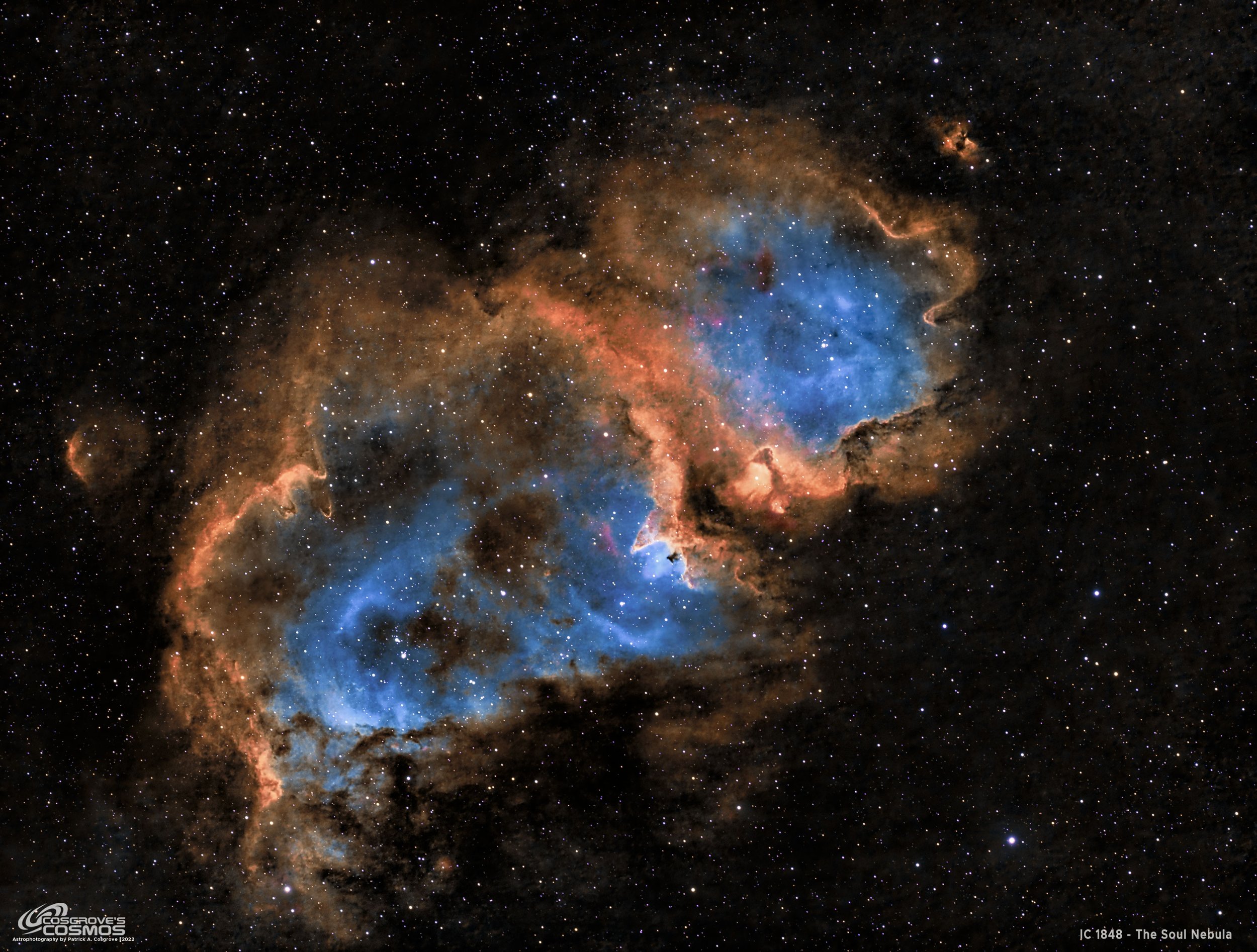Imaging Projects
In this blog, I will share the results of all of my imaging projects. The newest will be at the top and the oldest will be further down the stack. Going back in time here is interesting - some of my early stuff was pretty rough - but I did not see it that way at the time - I was thrilled to get anything back that looked like an image! Hopefully, you will see how my work has progressed with time!

Messier 42/43 – The Great Orion Nebula - 6.35 hours in HaLRGB
Orion’s sword is one of the most famous regions in the night sky, and for good reason. This widefield take on M42/M43 and the Running Man blends short and longer RGB/L exposures with H-alpha to balance the bright core against the faint, sculpted outer nebulosity—an image that showcases both the beauty and the ongoing starbirth of our nearest major stellar nursery.

SH2-157 – The Lobster Claw Nebula - 34.5 Hours of SHOrgb! Plus The Bubble Nebula!
A 34.5-hour SHO+RGB portrait of Sh2-157 (the Lobster Claw) with the Bubble Nebula in frame—captured over five October nights with the FRA400/ASI1600 and processed in PixInsight; full workflow and annotations inside.

LDN 1251 - The Rotten Fish Nebula (18.9 hours LRGB)
My second dark nebula image ever!
This image results from 19 hours of LRGB exposure with my FRA400 scope.
This was a challenging image to process as the nebula was so tenuous. I also had to deal with microlensing effects on the bright stars due to the ASI1600MM-Pro sensor.

SH2-124 - The Hidden Nebula (~14.2 hours in SHOrgb)
SH2-124 is a rich region of stars, dark dust, and emission nebulae located about 8,500 light-years away in the constellation of Cygnus.
This image is the result of 14.2 hours of SHOrgb data collection with my small Akskar FRA400 telescope platform.

LDN 1235 - The Shark Nebula - My 1st Attempt at a Dark Nebula (7.4 hours LRGB)
My first dark nebula image!
This image results from 7.4 hours of LRGB exposure with my FRA400 scope.
This was a challenging image to process as the nebula was so tenuous. I also had to deal with microlensing effects on the bright stars due to the ASI1600MM-Pro sensor.

Markarian’s Chain - A Famous Galaxy Cluster with 4.6 hours LRGB
Markarian’s Chain is a group of galaxies 50M light-years away moving together through space.
This image results from 4.6 hours of LRGB exposure from my FRA400 scope. This is the first image from this scope since it was moved to the new observatory!

Reprocessing Project: Messier 31 - The Andromeda Galaxy (6 hours in LHaRGB)
This version of M31, taken in November 2021, is my favorite. But it has been a few years since I first captured and processed this data. I have learned a lot since then, and I also have some excellent new processing tools at my disposal, so I wanted to see where I would end up if I were to start from scratch with the data, and this is the result!
Let me know what you think of this new image!

NGC 7822 - The Central Portion of the Question Mark Nebula (~14 hours in SHOrgb)
NGC 7822 is the Clamshell Nebula - located 2900 light years away in the constellation of Cepheus. This is a very large target, and with my smallest scope, I could still only fit the central portion of this complex area into the camera's field of view. This image results from just under 14 hours of integration and consists of a mix of narrowband data for the nebula and broadband RGB data for the stars.

SH2-119 The Clamshell Nebula (3.5 Hours in SHO) - An Unintended Image
My second image of the year started as a disaster and motivated me to move to NINA. I spent a few nights learning NINA during the bright Moon cycle, knowing the subs would be a waste. Lo and behold, there was an image there!
This is SH2-119—The Clamshell Nebula—3.5 hours in SHO. Read the story of my trials and tribulations that led to this image!

SH2-82 - The Little Cocoon Nebula - 7.3 Hours in LRGB
My first image of the year - and my first image from my new home after the move!
This is SH2-82—The Little Cocoon Nebula—7.3 hours in LRGB. Located ~4,000 light-years away in the constellation Sagitta, this emission/reflection nebula is in a rich region of the sky with a multitude of stars and dark dust lanes.

A Reprocess of SH2-157, The Lobster Claw Nebula - 4.25 hours in SHO.
SH2-157, The Lobster Claw Nebula, is located 11,000 light-years away in the constellation of Cassiopeia. This is a Reprocess Project - working with data in 2024 that was captured in 2021. I wanted to see if I could improve on this image. I think I did!

WR 134 - A Wolf-Rayet Star Region In Cygnus- 15.5 Hours in SHO
This is the third and final Imaging Project resulting from data collected during a recent - and very rare for this year - clear string of nights!
This is WR134 - a Variable Wolf-Rayet Star located 6,000 light-years away in the constellation Cygnus. This is a very interesting and rich area of the sky with a lot of objects in view. This includes WR134, WR135, and WR137 - the very first Wolf-Rayet stars ever found. These stars stood out as they had broad emission lines in their spectra instead of just absorption lines typically seen in stars.. These stares are massive and hot and have short lives.

SH2-132 - A Reprocess of The Lion Nebula in SHO (8.33 hours)
This is an Image Reprocessing Project for SH2-132, also known as The Lion Nebula - whose data was originally collected in September of 2021.
The Lion Nebula is a rich HII region with star clusters, emission nebulae, and dark dust regions. Located in the southern portion of the constellation Cepheus, the Lion Nebula is roughly 10,00 light-years away in the Perseus Arm of the Milky Way Galaxy. This is a very faint and challenging target.
This image was taken on the Askar FRA400 Platform with 8.33 hours of exposure in narrowband.

Messier 101 Supernova SN2023ixf ~3 Hrs in LRGB - Yet Another Supernova Shot - But This One Is Mine!
With the recent discovery of a bright supernova in the well-known Messier 101 - The Pinwheel Galaxy - a lot of astrophotographers have been going out of their way to grab an image of this galaxy during this event.
As a result, there are many - probably TOO many - images of this going around.
So why take an image myself? Is it because I think I can do better? NOPE! After all, I shot this on a widefield scope not suitable for galaxies, and I ended up shooting through smoke and with too little integration. So why do it?
Well - I wanted my own image of this event- and I wanted an excuse to explore what supernovae really are - after all - here I am looking at one!
So this posting will delve into this topic….

IC 1848 - The Soul Nebula - 6.8 hours in SHO (and a Change in Horses Mid-Stride!)
IC 1848, Better known as The Soul Nebula, is an emission nebula located 6,500 light-years away in the cancellation of Cassiopeia.
This image results from 6.8 hours of narrowband data collected with my Askar FRA400 Astrograph and my ZWO classic ASI1600MM-Pro camera on the nights of Oct 20 and 22 and Nov 23 of 2022.
The first two nights were collected using the IOPtron CEM26 mount, and the third night was collected using a brand new ZWO AM5 Harmonic mount. This was the first time using the AM5, and it did an exceptional job with tracking errors reduced by 400%!

SH2-114 -The Flying Dragon Nebula - a VERY Faint Challenge Target - 17.5 hours HSSrgb
SH2-114 - The Flying Dragon Nebula - is an extremely faint emission nebula found in Cygnus. This has proven to be a challenging target. Primarily shot as a Bi-Color Narrowband Ha/S2 image, I found it was very hard to see the nebula in a single 5-minute sub! I ended up going back to capture more data over 8 nights in total spanning two moonless cycles. I also collects RBG data so that I could replace the stars with natural color RGB stars. two moonless cycles of the moon to capture data over 8 nights. I ended up with a total of 17.5 hours - my longest integration to date! And still it was a challenge to process this image!

Messier 8, 20, and 21: A Rich Region in Sagittarius - 3.9 hours in HaRGB
This imaging project is a group photo taken in a rich portion of the constellation Sagittarius. It is the result of just 4 hours of LHaRGB integration. In this group, you can see Messier 8 (The Lagoon Nebula), Messier 20 (The Trifid Nebula), and Messier 21 ( Webb’s Cross). Also seen is the “Fist” shaped nebula on the upper left that is most strongly associated with IC 4685. This was taken with my Askar FRA400 widefield scope platform.

IC 4592 - The Blue Horsehead Nebula - 4.5 hours in LRGB
IC 4592, The Blue Horsehead Nebula is a faint reflection nebula located 400 light-years away in the constellation of Scorpius. This target is very large, measuring 1.5 x 3 degrees across was difficult to fit into the frame of my Askar FRA400 Astrograph! This beautiful and seldom imaged target was a challenge for me as it was located very low in the southern sky in an area with the smallest gap between my tree lines. About one hour of data was collected each night over four nights to produce this image.

Messier 106 Region - 5.7 hours LRGB
Messier 106 is a galaxy in Canes Venatici, located 20-25 million light-years away.
Galaxy Season is challenging time to find targets when you are dealing with a widefield telescope. I finally decided to image the region around M106 as it contains a host smaller galaxies.
This is a 5.6 hour integration in LRGB using my Askar FRA400 Astrograph and the ZWO ASI1600MM-Pro camera.

Messier 81/82 Wide Field: 3.5 hours LRGB - A Failed Quest for IFN!
I decided to try using my widefield Askar FRA400 platform to image the region around M81 & M82 to try and capture IFN (integrated Flux Nebula). This effort failed miserably! The resulting image was not too bad, but I was not able to get the kind of integration needed to capture this elusive feature! While this was a major disappointment, the resulting image shows M81, M82, and a third small galaxy NGC 3077 in a very nice part of the sky.
